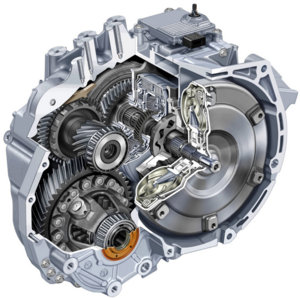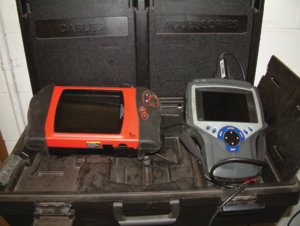Most modern automatic transmissions come equipped with electronic sensors and electric solenoids that are connected together by a module. Without these, most automatic transmissions will not get out of park. While these components can make a worn transmission shift like new, they can also make a mechanically healthy transmission malfunction.
Tooling up in order to diagnose these drivetrains means considering three areas of the transmission:
• Electrical testing for things like solenoids, neutral safety switches, etc.;
• Electronic testing/diagnostics for computer-controlled transmissions; and
• Pressure testing to check internal hydraulic fluid pressures.
 Multimeter
MultimeterOne of the first tools that should be in your box is a high-end multimeter. This tool is absolutely necessary to be able to sort out these transmission problems. When shopping for a meter, look for one that can handle 600 volts DC or more. It should be internally fused with a rating of at least 10 amps. Many meters are now rated 20 amps, which allows the tech more flexibility when testing. Many meters also now carrying CAT III certifications, which are important if you service hybrid vehicles. Look for a CAT III/1,000V rating. Other nice features include diode testing, dwell testing, temperature and the ability to display results graphically.
Pay special attention to the display. Are the digits big enough that you can comfortably read the screen? Is the display back-lit? This really comes in handy in low light conditions.
There are some great vehicle-specific single-use testers, such as solenoid testers/simulators. These tools allow the technician to verify that components are functioning independent of the vehicle’s control system and for diagnosing non-drivable vehicles.
Scan tools: From a quick code read to complete turnkey systems
Most new cars on the road today have some type of electronic controls integrated into the driveline. This means the car’s ECU(s) is communicating with the transmission, transaxle, differential, etc. And it also means you need a scan tool in your arsenal of weapons.

Scan tools can range from a low-cost “code reader” to a multi-thousand-dollar diagnostic system. Like most things in life, you get what you pay for in terms of value versus cost. Low-cost code readers are useful for quick diagnosis, and many experienced driveability technicians will keep one in their boxes for a quick scan or to verify if a repair has fixed an issue. These tools do provide valuable information, but in many cases it’s up to the user to decipher what the tool sees. There are some new low-cost tools coming into the market now that provide more robust features.
When shopping for a small, hand-held code reader, look for some of the following features: live data, readiness tests, read and reset codes. These tools generally will run from $100 to $300.
For the more complex problems, and to be able to access OEM-level information from the vehicle’s systems, you will most likely need a more sophisticated (read: expensive) solution. There are some great intermediate-level diagnostic platforms out there that provide significantly more information than the code readers, but remain affordable.
These tools offer features like upgradeability, manufacturer support, tech phone lines, print capability and serial outputs to allow you to send information to your PC. Pricing on these types of scan tools will range anywhere from $300 to $1,000.
The last and most powerful diagnostic scan tools are the complete systems offered by several of the largest and most respected tool companies in the industry. These systems are often complete turnkey systems from the manufacturers. They may offer software that is specific to domestic, Asian, European and heavy-duty vehicles. Some companies offer the ability to reflash (reprogram) the car’s computers. There are kits that feature software that allows you to service brakes, ABS, airbags, etc.
When making a buying decision on a system of this magnitude, make sure you have a list of questions for your tool dealer written down. Don’t be afraid to ask to speak to a factory rep if the dealer can’t answer your questions. Most of the larger tool companies have tech support lines staffed with technicians who can “talk the talk.”
 Multimeter
Multimeter Scan tools can range from a low-cost “code reader” to a multi-thousand-dollar diagnostic system. Like most things in life, you get what you pay for in terms of value versus cost. Low-cost code readers are useful for quick diagnosis, and many experienced driveability technicians will keep one in their boxes for a quick scan or to verify if a repair has fixed an issue. These tools do provide valuable information, but in many cases it’s up to the user to decipher what the tool sees. There are some new low-cost tools coming into the market now that provide more robust features.
Scan tools can range from a low-cost “code reader” to a multi-thousand-dollar diagnostic system. Like most things in life, you get what you pay for in terms of value versus cost. Low-cost code readers are useful for quick diagnosis, and many experienced driveability technicians will keep one in their boxes for a quick scan or to verify if a repair has fixed an issue. These tools do provide valuable information, but in many cases it’s up to the user to decipher what the tool sees. There are some new low-cost tools coming into the market now that provide more robust features.













